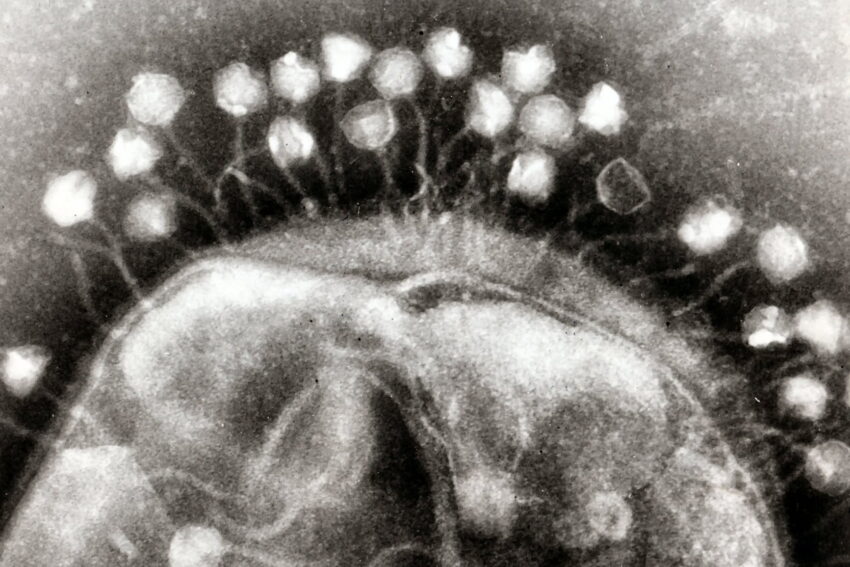Transduction is the process by which foreign DNA is introduced into a bacterial cell by a bacterial virus or a bacteriophage.
Bacteriophage is a virus that infects and replicates within a bacterium. Bacteria are host for bacteriophage. It is capable of attaching to the bacterial cell wall and injecting its DNA to the bacterium. Inside the bacterium, viral DNA replicates and synthesize proteins, enzymes and necessary components and make its multiple copies. Hence, bacteriophage is dependent on bacteria for DNA replication and protein synthesis machinery. During this process, bacterial DNA is degraded into pieces and get integrated with viral genome or, viral DNA gets integrated within bacterial DNA. The bacteriophage released from bacterial host carries the segments of bacterial DNA. When these bacteriophages infect new bacterial host, it causes mixing of bacterial DNA segments from new and former host. Hence, bacteriophage behave like a vector or a vehicle for carrying bacterial DNA and injecting into new host.
There are two types of transduction processes :-
- Generalized or lytic transduction
- Specialized or lysogenic transduction
Generalized or lytic transduction –
There are two types of bacteriophages: virulent and temperate. Virulent bacteriophage is capable of killing the host bacterium. They always undergo lytic life cycle which causes the death of host bacteria. Infection of a bacterium by a virulent bacteriophage and transferring bacterial DNA to another bacterium during the second infection is known as generalized transduction. Hence, generalized transduction can be defined as the transfer of bacterial DNA from one bacterium to another bacterium by a virulent bacteriophage during the lytic cycle of the bacteriophage. Bacterial DNA transfer happens due to errors of genetic material packaging in the new phages. The packaging of newly replicated viral DNA into new phages shows low fidelity. Hence, during the genetic material packaging, small pieces of bacterial DNA or recombined bacterial DNA with viral DNA can be included into phages wrongly. If bacterial DNA is inserted inside the viral capsid by chance, the second infection introduces this DNA into another bacterium. Hence, the DNA segment from one bacteria to another is transferred by a virus. This is example of horizontal Gene Transfer called as transduction.
The steps of generalized transduction are as follows:-
- A virulent (lytic) bacteriophage infects a bacterium.
- The phage genome enters the bacterial cell.
- Virus governs the bacterial metabolic mechanisms to make its own DNA and other necessary components and enzymes.
- Bacterial DNA hydrolysis into small pieces.
- Genetic material packs inside the new phages. Occasionally bacterial DNA fragments pack in new phage capsids.
- Bacterial cell lyses and releases the new phages.
- When transduced phage infects another bacterium, the previous bacterial DNA incorporates into new cell or host.

Lytic and Transduction cycle
Specialized or lysogenic transduction Temperate bacteriophages show lysogenic life cycles. They are involved with specialized transduction process in which a fragment of bacterial DNA is transferred from one bacterium to another bacterium due to an error. Hence, specialized transduction can be defined as the transfer of donor bacterial DNA to another bacterium by the temperate bacteriophages. When temperate phages infect bacteria, they are able to integrate viral DNA into bacterial chromosome and remain in the prophage stage for several bacterial generations without releasing it from the bacterial genome.
During the bacterial genome replication, viral DNA is also subjected to replication and Hence, it enters into new bacterial cells and survives. However, when the prophages are induced by the certain factors, viral DNA detaches from the bacterial chromosome. Sometimes during this detachment, fragments of bacterial chromosomes detach and remain attached to prophage DNA. Due to the induction, phages undergo lytic cycle. Viral genome replicates with attached bacterial DNA and packs inside new capsids and makes new phages. New phages release the bacterial cell by lysis. When a new phage infects another bacterium, bacterial DNA transfers to it.
The steps of specialized transduction are as follows:
- A temperate bacteriophage infects a bacterium.
- Viral DNA integrates into bacterial chromosome and becomes the prophage stage
- Viral DNA remains within the bacteria for several generations
- Upon a spontaneous induction, viral DNA detaches the bacterial chromosomal DNA.
- Fragments of bacterial DNA detach from the bacterial chromosome with viral DNA.
- Viral DNA replicates together with bacterial genes and package inside new capsids and make new phages
- Bacterial cell lyses and release new phages.
- New phages infect new bacteria.
- Bacterial DNA mixes with new bacteria during the infection.

| Generalized Transduction | Specialized transduction | |
| Definition | It is done by virulent or lytic bacteriophage | It is done by temperate phage |
| Life Cycle | Lytic | Lysogenic |
| Lyses of bacteria | Bacterial cell lyses quickly | Bacterial cell does not lyse quickly but survive for several generations. |
| Packaging of genetic material | A portion of donor bacterial DNA is enclosed within viral capsid | Small parts of bacterial DNA remains attached to viral DNA during the detachment from the bacterial chromosome and are packed into new capsids |
| Integration of viral DNA | Viral DNA is not integrated into the bacterial chromosome | Bacterial and viral DNA integrates |
| Hydrolysis of bacterial DNA | Bacterial DNA hydrolysis into pieces by the virus | Bacterial DNA is not hydrolysed |
| Prophage | There is no prophage production | Prophages are formed |


